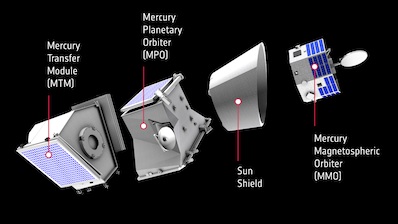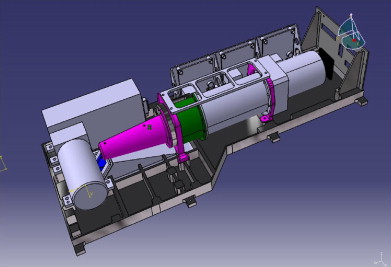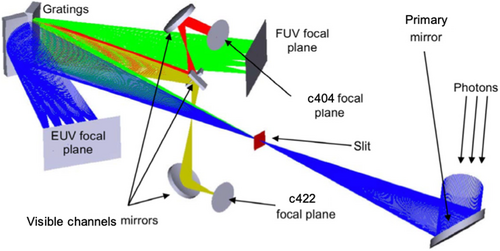Contribution of the Yoshikawa-Yoshioka Laboratory to the BepiColombo Mission
BepiColombo is a joint Mercury exploration mission between JAXA and the European Space Agency (ESA).
It consists of two spacecraft: the Mercury Magnetspheric Orbiter (MMO) developed by JAXA and the Mercury Planetary Orbiter (MPO) developed by ESA.

Many elemental species in Mercury’s thin atmosphere are released from surface minerals due to the influence of the space environment and quickly dissipate into space. Therefore, Mercury’s atmosphere is an important subject of study for understanding the physics of the space environment—the celestial rarefied atmosphere—and the celestial surface coupling system.
We were responsible for the overall development of the Mercury Sodium Atmosphere Spectrometer (MSASI) onboard the MMO. Additionally, we were involved in the development of the detector component of the Mercury Exosphere Ultraviolet Spectrometer (PHEBUS) onboard the MPO.

We also calibrated the data from the radiation monitor (SPM) onboard the MMO and conducted research on space weathering caused by the interaction between Mercury’s surface and high-energy particles.
The mission is scheduled to enter Mercury’s orbit by the end of 2026, and we plan to collaborate with students from our laboratory to analyse the data from Mercury.
Mercury Sodium Atmosphere Spectral Imager (MSASI)
It is not known why sodium atmospheres surround Mercury. MSASI detects the faint light emitted by sodium and investigates the distribution of sodium atmospheres (Yoshikawa et al., 2010).

Probing of Hermean Exosphere by Ultraviolet Spectroscopy (PHEBUS)
Due to intense sunlight, various elements boil up from the surface of Mercury and fly into space. These elements may include components that are still unknown. PHEBUS will observe the outer atmosphere of Mercury using ultraviolet rays to investigate the elements that escape into space (Quémerais et al., 2020).

Solar Particle Monitor (SPM)
Although primarily a housekeeping instrument for measuring ambient radiation, the Solar Particle Monitor (SPM) onboard BepiColombo can measure high‐energy particles, making it useful for observing phenomena such as galactic cosmic rays and Solar Energetic Particles (SEPs). However, it only records time‐series data of particle energy loss and counts, which requires characterization by radiation simulation for scientific analysis. In this study, a physical model of the SPM was constructed using the “Geant4” radiation simulation toolkit to investigate its response to charged particles (Kinoshita et al., 2025: The student of Yoshioka Lab.).

